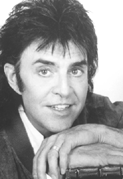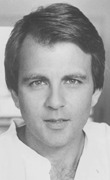Rock & Roll Forever
These aging teen idols take a licking but they just keep ticking
By Kelly Luker
Twilight begins to settle over the Pacific Ocean, illuminating a cool indigo backdrop for the Santa Cruz Boardwalk bandstand perched at the water's edge. The still-hot sands in front of the stage have been quilted together with hundreds of beach towels and blankets, each one marking the private reserve of a concertgoer who will reclaim it close to show time. Obligatory Jan and Dean, Beach Boys and Ventures tunes pour out of the loudspeakers as the sound check progresses.
At precisely 6:30pm, the dressing room doors fly open and the band pours out, led by a grandfatherly gent garbed in revolutionary dress and a tri-corner hat. As Paul Revere and the Raiders break into "Kicks," a song that sold millions 30 years ago, half the fans in the audience struggle to their feet, ready to shake some middle-aged, cellulite-scarred booty.
The life of a has-been isn't half bad if one gets past the silly notion that music is art or revolution or rebellion. Flash-in-the pans as diverse as the Tokens ('The Lion Sleeps Tonight"), Fabian, Jefferson Starship and the Platters have found that careers as long as 20, 30 and 40 years can be forged in what's referred to as "soft-ticket" venues.
While many musicians on the comeback trail--Kiss, the Sex Pistols or the Eagles, for example--can still fill arenas with fans who will pay top dollar, there is a whole other tier of performers who carve a nice living out of filling the usually free seats at county fairs, corporate conventions and theme parks. Known in the entertainment industry as nostalgia or classics acts, they are the men and, to a much lesser degree, women who have resurrected themselves, building profitable careers around one or two hit singles. And the performers don't even have to be--and rarely are, in fact--the original gang that created the song. A good case in point is tonight's featured band.
When Dick Clark signed them on as the house band for his immensely popular television show Where the Action Is in the mid-'60s, Paul Revere and his Raiders crooned and jiggled their way into the hearts and budding libidos of millions of pubescent girls. Backed by go-go dancers and fronted with screaming fans, the band brought the carefree Southern California beach life to landlocked kids nationwide five days a week.
Wearing skin-tight pants and high leather boots, lead singer Mark Lindsay was the sexy one, growling out AM hits like "Kicks," "Good Thing," "Ups & Downs" and "Hungry." Guitar player Fang was the funny, cute-like-your-kid-brother one. Then there was frontman Paul Revere, who, though funny and entertaining, was neither sexy nor cute.
Flash forward almost three decades to where the band is belting it out tonight, and something seems to be missing--the bandmembers. Fang, Lindsay and the rest are nowhere to be seen. For on the comeback circuit, who gets use of the band's name merely signifies who scored the best lawyer. No matter, since it isn't costing the graying boomer audience a dime.
Revere, if nothing, is a consummate showman. Between numbers sung by his Mark Lindsay sound-alike vocalist, the madcap performer, now 59, introduces his son on guitar and brags about the grandkids, then gets a few yuks from the audience by quipping about Geritol and hemorrhoids.
The few teens in the audience look on curiously, trying to size up what, exactly, the attraction is.
Missing in Action
The raiders' ex-vocalist, Mark Lindsay, knows exactly what it is: "We provide the soundtrack for the picture that goes in their minds." Lindsay also works the nostalgia circuit, booking somewhere between 75 and 100 gigs a year. Unlike his former front man, Revere, whose manager insisted that questions must be faxed to him first, Lindsay seems pretty down to earth. He's talking about how he can keep doing this year after year. "As long as it's still fun, I'll do it," he says.
While we talk, the movie Spinal Tap plays out behind our conversation. In this classic mock-rock-documentary by Rob Reiner, the plummeting popularity of a hard-rock band moves them from playing arenas to serenading curious passersby at the local animal theme park. Part of the beauty of this cult-flick satire is how Reiner grasps the band's labored nonchalance in playing gigs like an Air Force Academy graduation dance. Is this what it's like for these oldies but goodies who once enjoyed a brief moment in the spotlight?
The former heartthrob doesn't mind the question. Once gawky, with thick horn-rimmed glasses, Lindsay's younger years gave no indication that the rough-voiced singer's face would eventually plaster hundreds of teen magazines and be greeted by thousands of screaming, fainting fans when Paul Revere and Raiders made live appearances. The power of daily TV exposure from Where the Action Is only increased his popularity, making Mark Lindsay very rich and hungrily sought after. "It was much more desirable to be that guy on TV than who I thought I was," he admits. "I couldn't stand it if people wouldn't recognize me."
Of course, that level of adulation died, as it always must, and left Lindsay spiraling into what he terms a "post-partum depression. Suddenly, there wasn't all that attention," Lindsay remembers. "There's a real temptation to get off at the top, like Joplin or Morrison. It's a surreal life."
After an extended bout of what Lindsay delicately refers to as "self-medication," he was able to move on. "When the lights go out, I know it's the end of the gig today. I live in a small town and I have a normal life. And it's okay."
Lindsay has kept his thumb in the music biz ever since the Raiders' demise. Besides writing and producing, he did voice-overs, wrote commercial jingles and composed scores for several movies. Unlike many of his contemporaries, it was probably more than the dough that brought Lindsay back on stage in the '80s.
But, according to various agents and bookers in the business, the bucks ain't bad. Rich Dressler, promotions manager of the Santa Cruz Boardwalk, says his company pays its acts an average of $8,000 an evening. That would gross acts who work steadily like Lindsay about three-quarters of a million dollars a year.
Hits Hit the Fan
Those mining the nostalgia niche are relegated to one of two camps--pre-Beatles and post-Beatles. That watershed moment helped fuel the success of bands like the Raiders, who, although still purveyors of bubble-gum rock, discovered that long hair and faux-rebelliousness could move wax. Yet the Fab Four were the death knell to a whole era of performers. Fabian, for instance.
"When the Beatles hit, it knocked the shit out of what the American acts were doing," says Oscar Arslanian, manager to Fabian and a host of other nostalgia performers. "Some never stopped performing, but they became oldies real quick."
Arslanian's client was one of them. How Fabian Forte became an overnight success is more a testament to vulturous agents hungry for the "next big thing" than Fabian's inherent talents. Discovered at 14 sitting on his front steps in Philadelphia, the gorgeous young kid with beautiful eyes soon found himself on stage in front of thousands of adoring young girls.
"The early acts were packaged," remembers Arslanian. "They were all kids that were put on yellow school buses and doing one-nighters." Fabian was on the road by 15 and the silver screen by 16, positioned to be the next Elvis Presley, Paul Anka or Bobby Darin. In the wake of the British Invasion, Fabian capsized along with most of the other packaged acts, but resurfaced a few years later to helm the nostalgia movement with Bobby Rydell and Frankie Avalon, whom he often tours with.
The 52-year-old crooner is moving into 40 years of singing "Turn Me Loose," a nightmare that must resemble the movie Groundhog Day, in which the lead character is forced to live the same day over and over.
But that's not how Fabian sees it. The only difference between performing now and in 1957 is, "I'm a lot more grateful," laughs Fabian.
Looking like a '50s hepcat in tight black Levi's and black T-shirt, the man still looks damn good as he takes a few more drags off a smoke before hitting the Boardwalk stage. He removes his shades to reveal startlingly blue eyes. "I grew up with my audience," he says, and figures the secret to performing this long, at his age, is "agony." But, he adds with classic Philly inflection, "Whaddya gonna do?"
No, Fabian doesn't get nervous anymore before he hits the stage. The gang he grew up with begins cheering and whistling as the former idol appears, and laughs at his by-now-obligatory aging jokes. "Now, here's a little tune you might remember," the singer teases the crowd, before breaking into--what else?--"Turn Me Loose."
And, in some odd way, Lindsay's words begin to make sense. As a couple past their mid-century mark sways back and forth, his liver-spotted arms wrapped around her expansive girth, today really doesn't exist anymore. Mortgages and lousy jobs, ungrateful kids and failing health are washed away in the crooner's presence, as screams and laughter from an ancient roller coaster punctuate the warm summer night. That particular soundtrack, whether it's from Fabian or the Coasters or the Shirelles or the Raiders, harkens to a different reality, where bellies are firm and passion is hot and the whole world is there for the taking.
Who knows if it's vanity or ego or the bucks that keeps these acts on the circuit year after year. But supplying a soundtrack for nostalgic fantasies ain't a half-bad incentive, either.
This page was designed and created by the Boulevards team.

One If by Walker, Two If by Gurney: The appearance of Mark Lindsay at the County Fair and Paul Revere & the Raiders at the Boardwalk is just the tip of a rock nostalgia iceberg.
Cardiac Arrest-ed Development: Former pop star and teen heartthrob Fabian still draws fans on the summertime nostalgic circuit.
From the August 8-14, 1996 issue of Metro Santa Cruz
Copyright © 1996 Metro Publishing, Inc.
